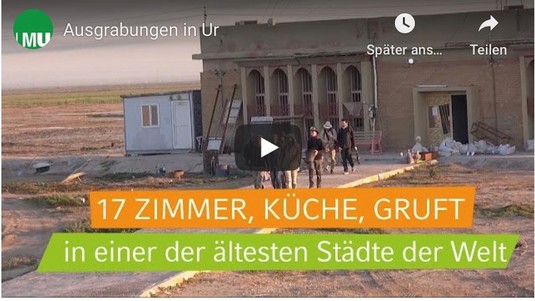UR
Excavations and Research in 2017, 2019, and 2022
supported by Gerda-Henkel-Stiftung and the Münchener Universitätsgesellschaft
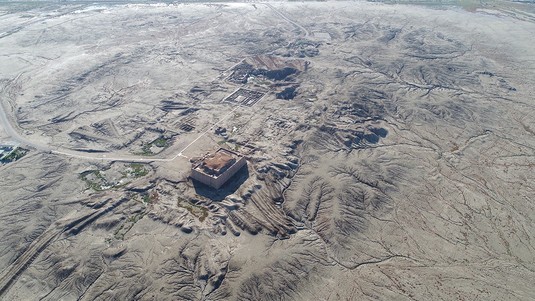
Project Description
A team from LMU Munich conducted excavations and a geophysical survey in Ur during two campaigns in 2017 and 2019. The research team, headed by Prof. A. Otto, participated in the excavations unter the direction of Prof. E. Stone (Stony Brook University, NY) and Dr. A. Hamdani at Ur (Southern Iraq), which have been taking place in Ur since 2015.
The LMU Munich team investigated the South Mound by means of a geophysical survey and limited excavations near the southern edge of the city.
This helped us to better understand the whole structure of the city. Additionally, the single house, which was carefully excavated, can serve as a model of an Old Babylonian house and enriches the understanding of the numerous houses and their remains, which had been excavated by Sir L. Woolley from 1926-1931.
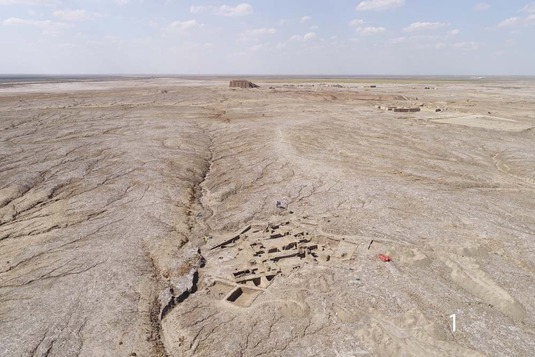
Situation and Stratigraphy of Area 5
Area 5 is situated close to the southern edge of the mound near the city wall (photo 1). Our aim was to examine if the Old Babylonian households at the periphery differed socially or economically from those situated in the city center, e.g. at AH, EM and EH.
The two upper levels consist of many intrusive Late Babylonian or Persian graves and a large Neo-Babylonian building, of which only shallow remains have been preserved due to the erosion.
A few walls and pits of the Kassite level have been preserved; they were built from reused bricks, which had been extracted from the Old Babylonian walls and contributed to their destruction (photo 2).
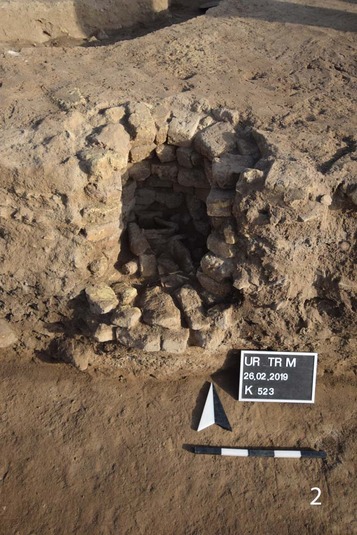
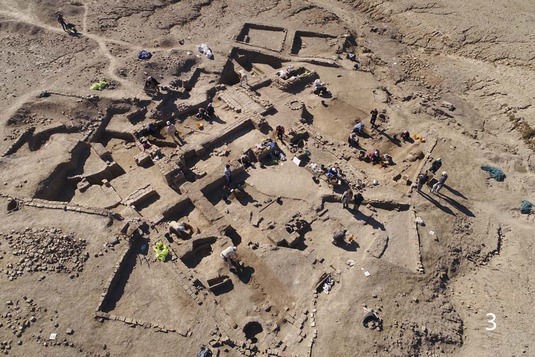
The house of Sîn-nada
The most important structure is a large Old Babylonian house which was excavated in 2017 and 2019. It consisted of 16 rooms and a courtyard, was erected in the Isin-Larsa period around 1850 BC and shows three main phases (photo 3). During the first phase it was inhabited by a certain Sîn-nada who was the shabra of the Ningal temple. Several texts found in various rooms of the house tell us that not only him but also his wife Nuṭṭuptum were involved in various temple affairs. Even letters sent by him to his wife when he was abroad were found (photo 4).
The impressions of Sîn-nada’s two seals give us even the precise dating of the phase to the Larsa kings Sîn-eribam and Silli-Adad (1842-1835 BC) (photo 5). He is named a servant of the respective king, and a clay plaque depicting the enthroned king was kept in his house.



The house was lavishly equipped with bathrooms, a large room for sojourn and areas for reception and offering. Several school tablets had been filed in one room (photo 6), more tablets and sealed labels had been discarded in the adjacent room, together with garbage (photo 7, photo 8). The kitchen area contained ovens and drains connected to food preparation (photo 9). A staircase led to the upper floor. The family tomb was built outside the house and consisted of a corbel vaulted structure, were the bones of 24 individuals were kept (photo 10). More burials consist of simple inhumations, clay coffins and pot-burials (photo 11, photo 12, 13).
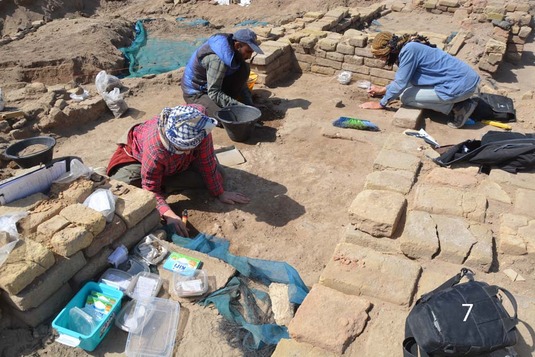
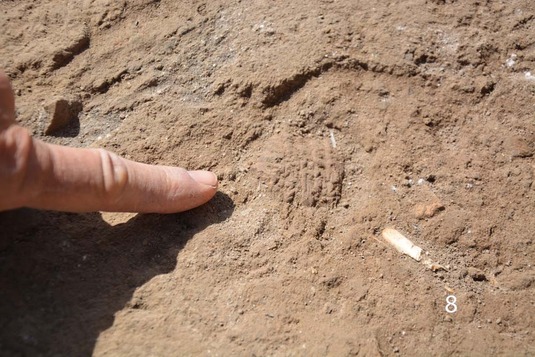
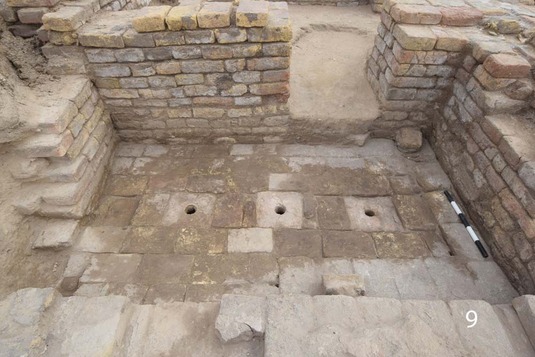
The anthropological analyses revealed quite healthy individuals with only few diseases or morphological symptoms of nutritional deficiency and rather low physical work load. The analysis of the ancient diet is presently under way through the study of the animal bones and botanical samples derived through flotation.
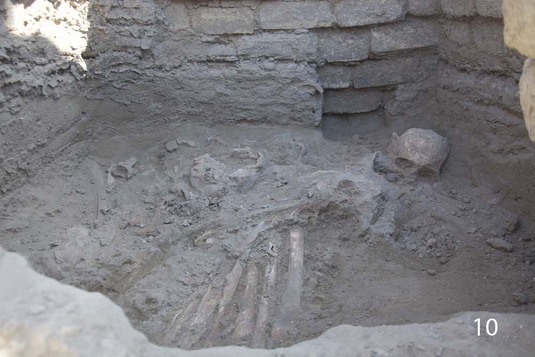
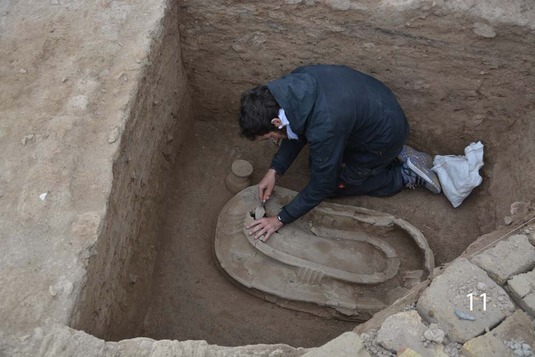
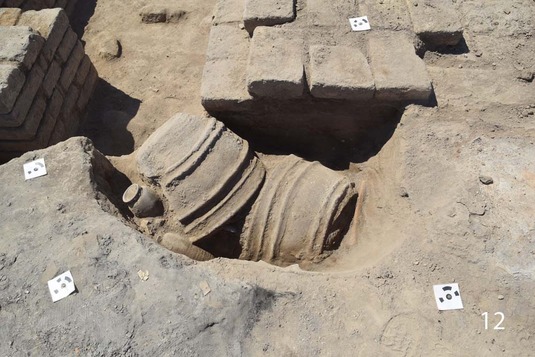
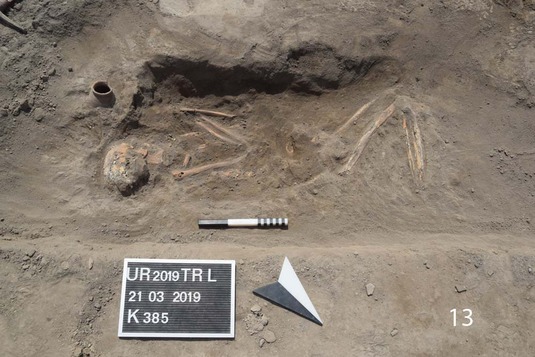
The house was altered during the second phase and all the floors were raised. A row of six rooms along the street was separated from the main house. One room was equipped with a large domed bread oven (photo 14), a basalt millstone for grinding the grain was installed in the neighboring room (photo 15). A few tablets in this level suggest a date under Rim-Sîn of Larsa.
The third and last phase has been preserved only in the northeastern rooms. Probably it came to an end with the overall decline of Ur during Samsu-ilunas reign.
In sum, it is certain that Sîn-nada’s family belonged to the elite at Ur and that the neighborhood of Area 5, although at the edge of the city, was occupied by wealthy people.
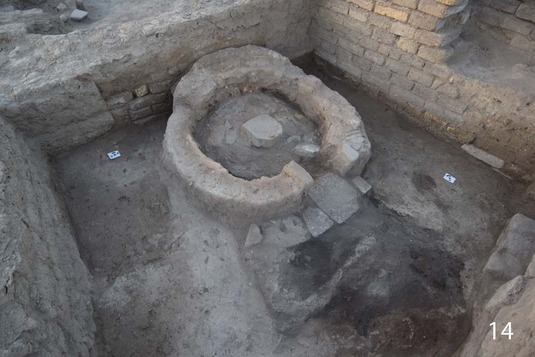
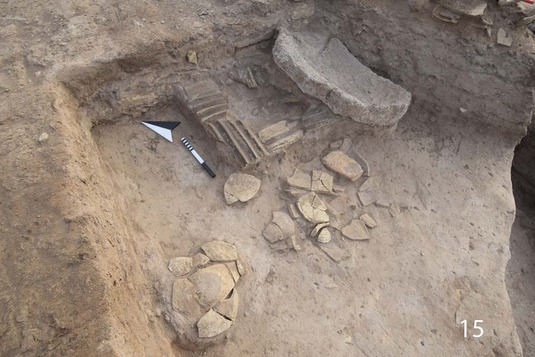
The Ur III level
The Isin-Larsa house was directly built on top of a Ur III level. This Ur III level consisted of an open courtyard area and was flanked by several allongated narrow rooms, which may have served for storage. We assume that this was an open place where goods were delivered and brought in from the nearby southern city gate, and was stored or distributed (photo 16).
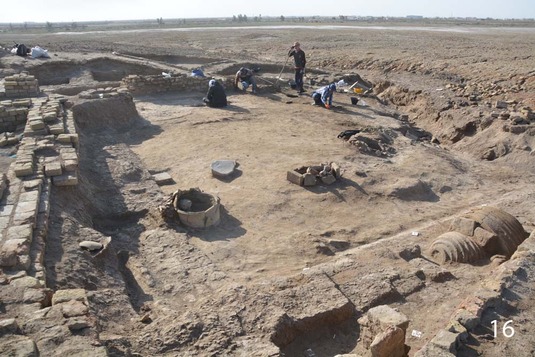
Geophysical Prospections
Prof. Joerg Fassbinder, Marion Scheiblecker, Sandra Ostner and Mandana Parsi (LMU Munich) prospected Ur in 2017 and 2019 with three handheld total field Caesium magnetometers and one handheld Foerster Ferex Gradiometer. Additionally and complementary over 20 ERT (electrical resistivity tomography) profiles were measured at three selected sites to get further information about the harbour, house and city wall constructions. (photos 17-19)
Although the deep wadis throughout the mound were challenging, the complete South Mound and parts of the western North Mound were measured, including the Western Harbour area. On the last day the East Mound, surveyed by E. Hammer, was measured.
The geophysical measurements revealed countless archaeological features all over the selected survey areas. The architecture of the Old Babylonian and the Neo-Babylonian period can be easily distinguished due to the use of both baked bricks and mudbricks respectively. Numerous domestic areas, larger buildings, streets, waterways, the city wall, kilns, tombs and other features can be distinguished mapping the ancient city of Ur.
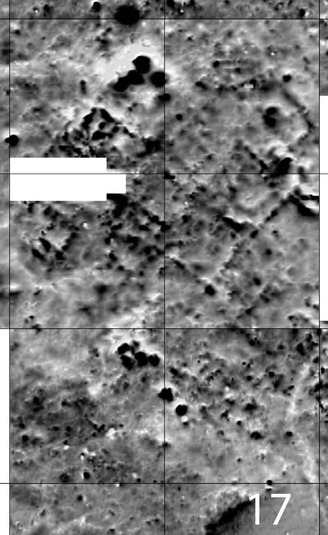
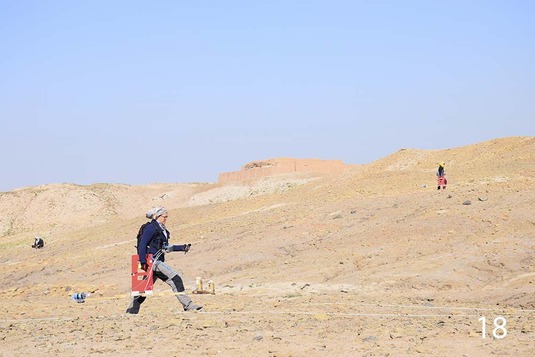
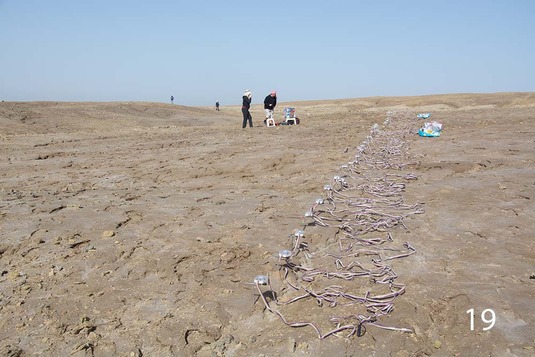
The Team
- Archaeology: Prof. Adelheid Otto, Dr. Berthold Einwag, Dr. Albert Dietz, as well as Pierre Borsdorf (2019), Jasmin Braun (2019), Dennis Busch (2017), Dr. Martin Gruber (2017, 2019), Johannes Hechtl (2022), Dr. Michael Herles (2017, 2019), Dr. Kai Kaniuth, Manfred Lerchl (2019), Dr. Elisa Roßberger (2017, 2019), Laurin Stöckert (2019)
- Anthropology: Dr. Andrea Göhring, LMU (2017, 2019)
- Cuneiform Texts: Prof. Dominique Charpin, Collège de France, Paris (2017, 2019, 2022), PD Dr. Anne Löhnert, LMU (2017), Prof. Walther Sallaberger, LMU (2019)
- Geophysics: Prof. Jörg Faßbinder (2019), Marion Scheiblecker (2017, 2019), Sandra Ostner and Mandana Parsi (2019) (all LMU)
- Botany and Zoology: Katheryn C. Twiss PhD (Stony Brook, NY); Michael Charles PhD (Oxford Univ. GB), Melina Seabrook (Harvard)
Acknowledgements
Our thanks go to his excellency Dr. Abd-el Amir Hamdani, minister for culture, Iraq, the director general of the Iraqi departement of Antiquities SBAH, Qais Rasheed and the representatives of the local antiquities service (SBAH) of Nasriyah. We thank all workmen from Nasriyah for their excellent collaboration.
Furthermore we want to thank Prof. Elizabeth Stone und Prof. Paul Zimansky (Stony Brook University), who generously allowed us to participate in their project. Also W. Brad Hafford PhD for his cooperation in the field.
These excavations were supported by the Gerda-Henkel-Foundtion and the Münchener Universitätsgesellschaft.
More Information
Campaign in spring 2017
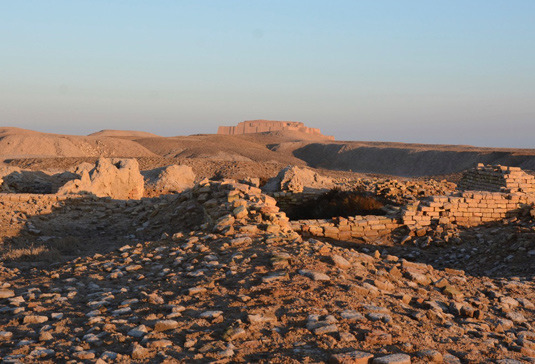
Archaeology
Insights into early urban life
27th March 2018
Campaign in spring 2019
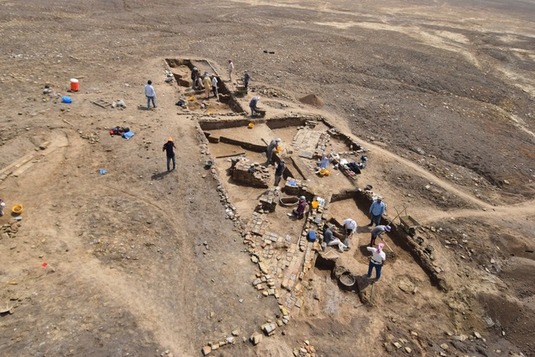
Archaeology
Secrets of a Babylonian Villa in Ur
16th July 2019
https://www.lmu.de/en/newsroom/news-overview/news/secrets-of-a-babylonian-villa-in-ur.html
UR video on YouTube: 17 ROOMS, KITCHEN, GRAVE in one of the oldest towns in the world
Articles
- Stone E. C. & P. Zimansky, 2016: “Archaeology Returns to Ur. A New Dialog with Old Houses”, Near Eastern Archaeology 79.4, p. 246-259.
- A. Otto, Official Seal Motifs at Larsa and Ur in the 19th Century BC, in: G. Chambon, M. Guichard, A.-I. Langlois, T. Römer et N. Ziegler (ed.), De l’argile au númerique: Mélanges assyriologiques en l’honneur de Dominique Charpin, PIPOAC 3 (2019) 763-776.
- D. Charpin, Priests of Ur in the Old Babylonian Period: a Reappraisal in Light of the 2017 Discoveries at Ur/Tell Muqayyar, Journal of Ancient Near Eastern Religions 19, 2019, 18-34.
- E. Stone, A. Otto, D. Charpin, B. Einwag, P. Zimansky, Two Great Households of Old Babylonian Ur. Near Eastern Archaeology 84.3 (2021), 182–191.
- A. Otto, Excavations at Ur (2017 and 2019), in A. Otto und K. Kaniuth (ed.), 50 Jahre Vorderasiatische Archäologie in München. MAAO 7 (2022) 350–357.
- A. Otto, A New Archaeological Response to an Old Question: When and how Did Ur Recover in the Old Babylonian Period? in N. Marchetti et al. (ed.,) Proceedings of the 12th International Congress on the Archaeology of the Ancient Near East, Wiesbaden 2023, 5–18.
Workshops
- EcritUr. Première Table Ronde, Paris, Fondation Hugot du Collège de France, 17 mai 2018
- Ur – Vorträge bei der ICAANE Munich 2018
- Ur Workshop LMU-München 26. Juli 2019 - Ur – Results of the 2019 campaign. Friday, 26th July 2019, 9.50 – 15.00; Historicum room K 001, Schellingstraße 12
Lectures
- 01/2020 - Wie lebte es sich in Babylonien vor 3900 Jahren? Erkenntnisse aus den neuen Ausgrabungen in Ur (Südirak), Eberhard Karls Universität Tübingen, IANES, 30.1.2020
- 12/2019 - Wie lebte man vor 3900 Jahren in Mesopotamien? Neue Ausgrabungen im Haus des Tempelintendanten in Ur (Irak), Archäologische Ringvorlesung, Georg-August-Universität Göttingen, 16.12.2019
- 05/2019 - Leben in einer Metropole um 2000 vor Christus: Neue Ausgrabungen in Ur, Universität Würzburg, 6. Mai 2019
- 09/2018 - New Research in Southern Mesopotamian Cities, Part 1: The Survey around Tell Fāra / Šuruppak, Part 2: Excavations at the South Mound of Ur, Yale University, New Haven, September 14, 2018
- 09/2018 - New Research in Southern Mesopotamian Cities, Part 2: Excavations at the South Mound of Ur : First results of the LMU team, Johns Hopkins University Baltimore, September 5, 2018
- 07/2018 - Excavations at the South Mound of Ur : First results of the LMU team (project E. Stone), RAI Innsbruck, July 20, 2018
- 04/2018 - The LMU Munich excavations 2017 at the South Mound of Ur, 11th ICAANE, Munich
- 05/2018 - The 2017 season of the LMU Munich team, EcritUr. Première Table Ronde
Paris, Fondation Hugot du Collège de France, 17 mai 2018 - 12/2017 - Die Münchener Ausgrabungen in Ur, Frühjahr 2017, Altorientalisches Kolloquium, 12.12.2017, Adelheid Otto, M. Scheiblecker, P. Paoletti, M. Gruber, A. Löhnert, E. Roßberger, A. Dietz, B. Einwag, A. Göhring, M. Herles, K. Kaniuth
UR Research
- Ur Online http://www.ur-online.org
- EcritUr (projet ANR 2017-2020)
http://digitorient.com/programmes-de-recherche/3-projets-de-lequipe-3-mondes-mesopotamiens/ecritur-projet-anr-2017-2020/ - Archibab http://www.archibab.fr/accueil.htm
- VisitUr https://www.thinglink.com/card/1311296659891683329
Contact
- Prof. Dr. Adelheid Otto: aotto@lmu.de
- Prof. Dr. Elizabeth Stone: elizabeth.stone@stonybrook.edu


